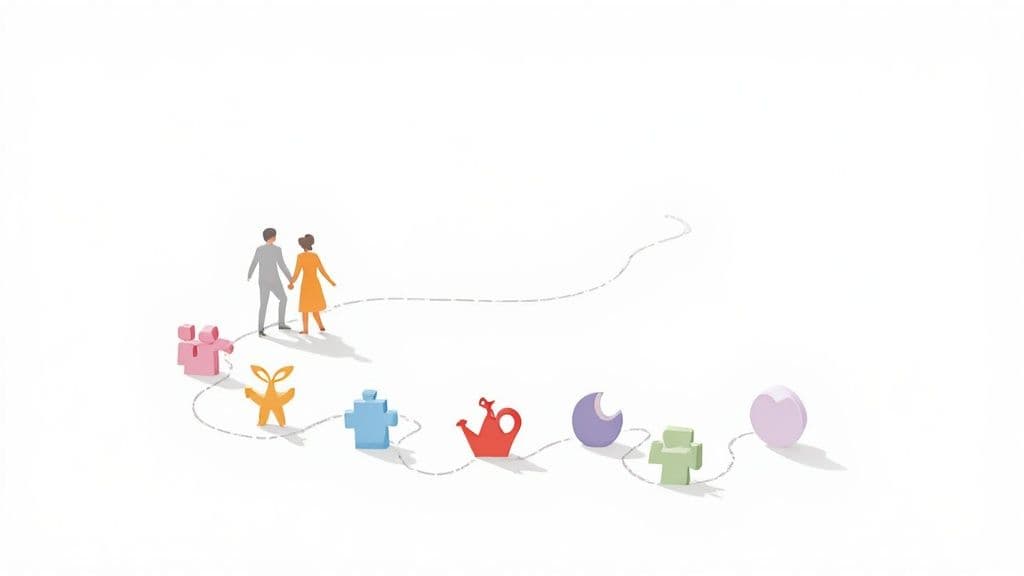Explore stages in a romantic relationship and uncover 8 key phases, with practical tips to strengthen your bond at every step.
November 13, 2025 (1d ago)
stages in a romantic relationship: 8 key phases
Explore stages in a romantic relationship and uncover 8 key phases, with practical tips to strengthen your bond at every step.
← Back to blog
Romantic Relationship Stages: 8 Key Phases
Explore the 8 stages of a romantic relationship and practical tips to strengthen your bond at every step.
Introduction
Ever feel like your relationship is a movie, moving from one scene to the next? One moment it’s a rom-com full of butterflies, and the next it feels like a heavy drama. Most romantic partnerships follow a natural progression — a roadmap that charts growth and challenges. Understanding these stages isn’t about boxing your unique connection; it’s about gaining clarity so you can navigate with awareness and intention.
This guide breaks down eight common stages couples move through and offers practical advice for each phase. It also points to tools that can deepen self-awareness and help you co-create a lasting connection.
1. Stage 1: Attraction and Initial Meeting
Every relationship often begins with a spark — the attraction and initial meeting stage, also called the "honeymoon" or infatuation phase. Intense feelings of excitement, curiosity, and desire are driven by brain chemistry and reward pathways.1 In this phase, both people tend to show their best selves and focus on potential, sometimes overlooking incompatibilities.

How to navigate this stage
- Be authentic: Show your real self, quirks and all.
- Ask deeper questions: Move beyond small talk to learn values and coping styles.
- Observe actions: Notice how they treat others and handle small stresses.
Key insight: Enjoy the romance, but gather information and notice subtle red flags.
2. Stage 2: Building Connection and Early Dating
After the spark comes intentional exploration. Conversations deepen, meetups become consistent dates, and you may introduce each other to close friends. This stage tests compatibility as you begin to picture how your lives might fit together.
How to navigate this stage
- Maintain independence: Keep friendships and hobbies alive.
- Discuss intentions: Clarify exclusivity and long-term goals.
- Share vulnerably, but pace it: Open up gradually and ensure reciprocity. See our guide on attachment styles in relationships for more on emotional patterns.
Key insight: Look for consistency between words and actions as the idealized image gives way to the real person.
3. Stage 3: Deepening Intimacy and Commitment
This is where security replaces uncertainty and commitment becomes explicit. Couples integrate lives through milestones like meeting family, discussing cohabitation, and planning a shared future.

How to navigate this stage
- Discuss long-term goals: Talk about career, family, finances, and lifestyle.
- Keep your identity: Encourage separate interests and friendships.
- Establish rituals: Weekly date nights or shared routines strengthen your identity as a couple. Improving how you communicate is crucial — see our piece on how to communicate better in relationships.
Key insight: Commitment is built in daily choices to prioritize and support one another.
4. Stage 4: Engagement and Commitment Planning
This stage shifts the relationship from promise to practical planning: engagements, legal arrangements, or serious cohabitation. Conversations turn to budgets, living arrangements, and long-term logistics.
How to navigate this stage
- Talk about money honestly: Discuss debt, income, spending, and consider a prenuptial agreement.
- Create a shared vision: Align on where you’ll live, career paths, and if children are part of the plan.
- Plan as a team: Share tasks and decisions fairly. A wedding checklist can help keep logistics manageable.
Key insight: Use planning as a chance to strengthen teamwork and set expectations for the life you’ll build together.
5. Stage 5: Marriage and Honeymoon Phase
Marriage often brings a honeymoon period of high satisfaction and optimism. It’s also when couples start merging daily routines, finances, and responsibilities.
How to navigate this stage
- Establish shared systems: Create clear agreements for chores and money.
- Prioritize connection: Schedule time for each other to prevent complacency.
- Communicate expectations: Be explicit about holidays, personal space, and roles.
Key insight: The habits you build now set the tone for long-term partnership.
6. Stage 6: Settling Into Stability and Routine
A settled rhythm brings comfort and predictability. You know each other deeply, but routine can also risk boredom or stagnation.
How to navigate this stage
- Schedule spontaneity: Plan new experiences to keep novelty alive.
- Prioritize individual growth: Maintain interests outside the relationship.
- Talk about the “boring” stuff: Regularly check in on satisfaction and future goals.
Key insight: Stability is the foundation, not the finish line; gratitude and deliberate novelty keep the relationship alive.
7. Stage 7: Crisis and Conflict Navigation
Every long-term relationship faces major stressors: infidelity, illness, job loss, or bereavement. How a couple navigates these crises often determines their future trajectory. Therapy and structured approaches increase the chance of repair.2
How to navigate this stage
- Seek professional help: A therapist can facilitate communication and healing.
- Address the issue, not the person: Use “I” statements to reduce defensiveness.
- Practice active listening: Aim to understand before responding.
Key insight: Crisis can be transformative when partners commit to honest repair and renewed trust. Research on relationship predictors highlights the role of conflict patterns in long-term outcomes.4 If divorce risk or major change concerns you, current national data can provide context about trends in marriage and separation.3
8. Stage 8: Evolution and Long-Term Partnership
In long-term partnerships, love becomes steady companionship. After decades of shared experience, the relationship centers on acceptance, shared meaning, and mutual care.

How to navigate this stage
- Create new meaning: Find shared projects like volunteering, travel, or mentoring.
- Invest in friendship: Keep laughter, curiosity, and shared hobbies alive.
- Document your legacy: Photo albums, stories, and rituals reinforce your shared history.
Key insight: Embrace change and keep choosing each other daily to ensure the relationship remains a source of joy.
8-Stage Comparison
| Stage | Complexity | Investment | Expected outcomes | Ideal use cases | Key advantage |
|---|---|---|---|---|---|
| Attraction | Low | Low emotional/novelty | High excitement, low stability | First meetings, dating apps | Strong first impressions |
| Early dating | Moderate | Time, social introductions | Growing trust, clearer compatibility | Evaluating fit, exclusivity talks | Deeper bonding opportunities |
| Deepening intimacy | High | Emotional integration | Strong emotional intimacy | Preparing to cohabit | Security and shared identity |
| Commitment planning | Very high | Financial/legal | Formalized plans | Preparing marriage, merging finances | Clear shared vision |
| Marriage & honeymoon | Moderate-high | Household coordination | High early satisfaction | Newlyweds | Team mentality |
| Stability & routine | Low-moderate | Ongoing maintenance | Predictability, risk of stagnation | Long-term equilibrium | Comfort and reliability |
| Crisis navigation | Very high | Emotional/financial/professional | Risk or growth | Handling major life stress | Opportunity for resilience |
| Evolution | Low procedural, high maturity | Sustained emotional investment | Mature companionship | Late-life partnership | Profound intimacy |
Your Unique Path Through These Stages
These stages are a map, not a rulebook. They help you anticipate transitions, celebrate milestones, and approach challenges with intention. Each phase offers opportunities for personal and relational growth.
Key takeaways
- Awareness is your compass: Knowing what’s normal reduces panic during transitions.
- Communication is the engine: Different stages require different kinds of conversation.
- Growth is mandatory: Stagnation is the real risk; keep evolving together.
For a deeper, individualized perspective, tools like the Life Purpose App use life-number frameworks to highlight shared strengths and friction points. Visit Life Purpose App to explore your and your partner’s life numbers.
Frequently Asked Questions
Q: What stage is my relationship in?
A: Look at patterns: intense novelty and infatuation point to attraction; growing consistency and deeper talk point to early dating; practical merging and long-term planning signal commitment stages.
Q: How long does the honeymoon phase last?
A: There’s no fixed timeline, but the intense infatuation typically fades within months to a couple of years as attachment and routine develop. Use the fade as a chance to deepen emotional intimacy rather than mourn the loss of constant novelty.
Q: When should we seek couples therapy?
A: Seek help when conflicts repeat, trust is broken, or communication stalls. Therapy is especially helpful during crises and can improve outcomes when both partners commit to the process.2
Discover Your Life Purpose Today!
Unlock your true potential and find your life’s purpose.
